Amateur Astrophotography
Skywatcher Skymax Maksutov-Cassegrain f = 1500mm / D=127mm F12 SynScan AZ GOTO
Skywatcher Skyhawk Newtonian f= 500mm (450mm) / D=114mm F4
Skywatcher Explorer 130PDS Newtonian, f=650mm / D=130mm F5 with Skywatcher Mount EQ5 Pro SynScan GoTo
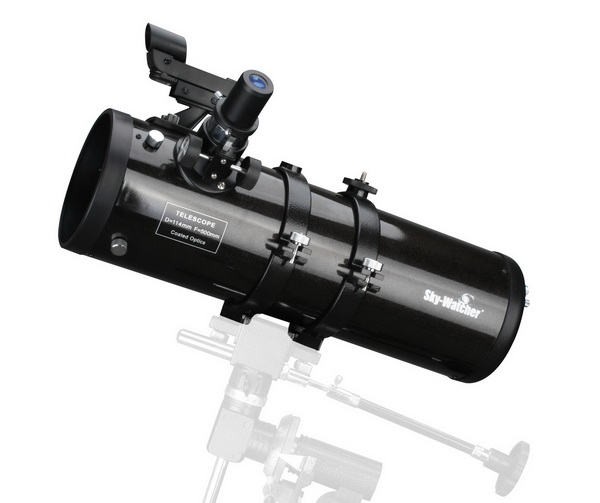
Charles Messier elaborated his famous catalog using a 100m aperture refracting telescope. What can be do with a similar telescope and a planetary camera? Are we able to visualize every Messier object and get a good idea on how they look like? This is the challenge!
So I got a new telescope, a Skywatcher SkyHawk Newtonian. Aperture 114mm, focal length 500mm, F4.4, parabolic mirror, and a plastic focuser which is a real shame! This telescope is a real gem, but the focuser makes things difficult. I can't understand such a lame focuser on a good telescope (all telescopes of this kind have exactly the same lame focuser!). They do so you buy more expensive telescopes for astrophotography. It's a lame strategy! Because of this, some previous work has to be done to get the telescope ready for action.
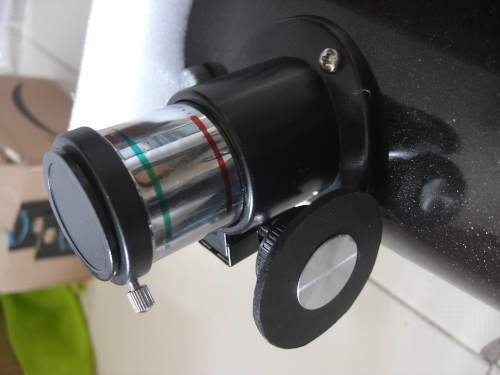
First thing to do with this telescope is to modify the focuser, so we are able to focus. Attaching a bigger wheel (double diameter) really helps a lot and makes a real difference (see the picture). I did a wood circular piece and glued with superglue. With this, and a Bahtinov mask, focusing becomes fairly easy. Then I also changed internal strips of nylon and replaced thicker ones, so the focuser play reduces. Checking with a laser collimator (SvBony makes cheapest and reliable ones), things get nearly perfect when I focus in upward motion of the focuser. This a key point to make the telescope work with my small and light planetary camera.
See the red line on the focuser? It indicates the position of the focuser when the planetary camera is on focus. It is very useful to draw that line, because when you are doing observation, you will get the camera nearly on focus very easily. Also, it is better to check collimation in the same position we are going to use the camera. Draw the red line!
About the collimation, things were nearly perfect on arrival. Because of the focuser play, you have to be careful on checking the collimation. Collimation should be checked after the focuser has been moved upward. Then I only had to slightly modify one or two screws of the secondary mirror. It took less than 10 minutes. The primary mirror was completely fine.
For the observations, I use my alt-az SynScan GoTo from my Maksutov telescope.
First target: M81, Bode's Galaxy
The first target was M81, also known as the Bode's galaxy. Located near the Big Dipper, at midnight, on 16th March 2021 it was located near the zenith, which facilitated its observation. Magnitude 6.9.
Located 12 million light-years from Earth, this spiral galaxy is 90,000 light-years in diameter. It is the right size for my setup and quite bright, so it is a good target to start with.
The images were taken on March 16. Gain was set to maximum. I did exposures of 5, 10, 20 and 30 seconds. The 20s exposures I did without IR/UV filter, and I believe it was the best choice. One of the advantages of working with a Newtonian is that you have NO CHROMATIC ABERRATION AT ALL!. Then, you can take advantage of the good sensitivity to infrared the IMX290 sensor offers.
A total of 531 images were obtained, processed using Deep Space Stacker (DSS), GIMP and Registax (wavelets).
The first image with a lighter processing:

The second one after processing the first one with Registax wavelets:
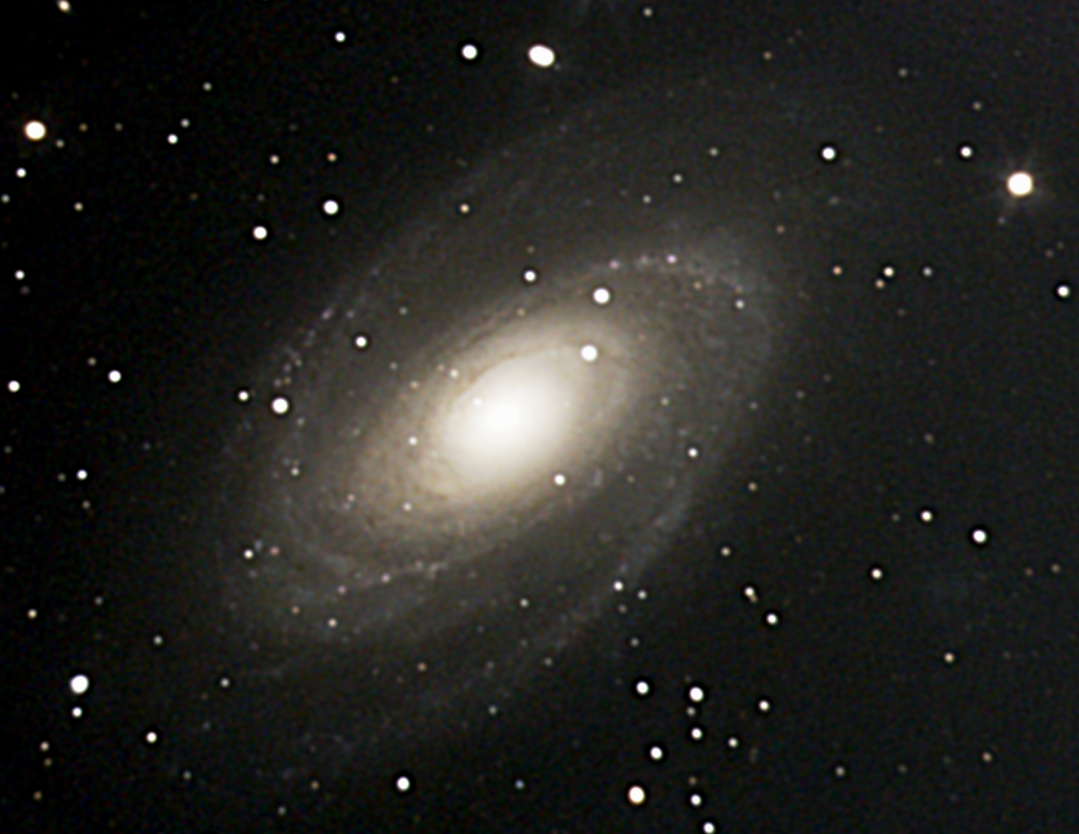
This one is the best one. Every little detail of this image can be found in the corresponding image of M81 taken by the HST (you can see in Wikipedia). I feel satisfied!
Second target: M101,
My second Galaxy, M101, also known as the Pinwheel Galaxy. Located near the Big Dipper, after midnight it is near the zenith, which facilitates its observation.
Magnitude 7.86
Located 27 million light-years from Earth, this spiral Galaxy has a diameter of 170,000 light-years, so it is quite large, larger than our Milky Way.
To obtain this image I used no filter. The light hits the sensor directly after bouncing off the two mirrors of the telescope.
The images were taken the night of April 4 2021, with the gain at maximum, with exposures of 30 seconds. These images were therefore obtained at the limit of the capacity of the camera (maximum gain) and of the mount itself, which is not equatorial, thus limiting the exposure time to a maximum of 30 seconds.
Night without moon or clouds, but with quite poor visibility due to the haze and humidity.
In total 386 images were obtained (3 hours of exposure).
223 were manually selected.
The images have been processed using Deep Space Stacker (DSS), GIMP and Registax (wavelets).
The final result, given the poor visibility and the equipment used, has very pleasantly surprised me.
The first image after a lighter processing:
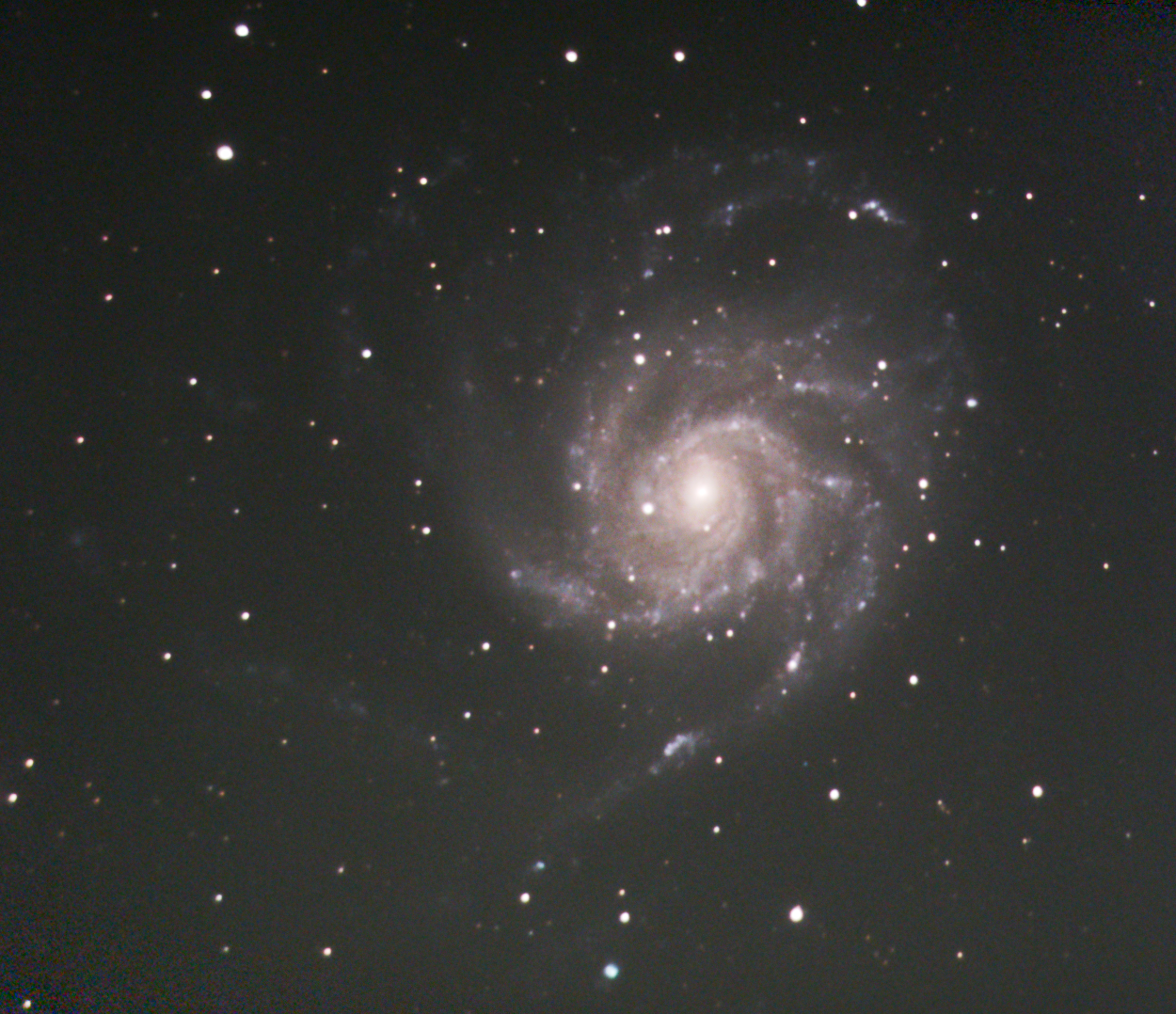
The second image after a heavier processing:
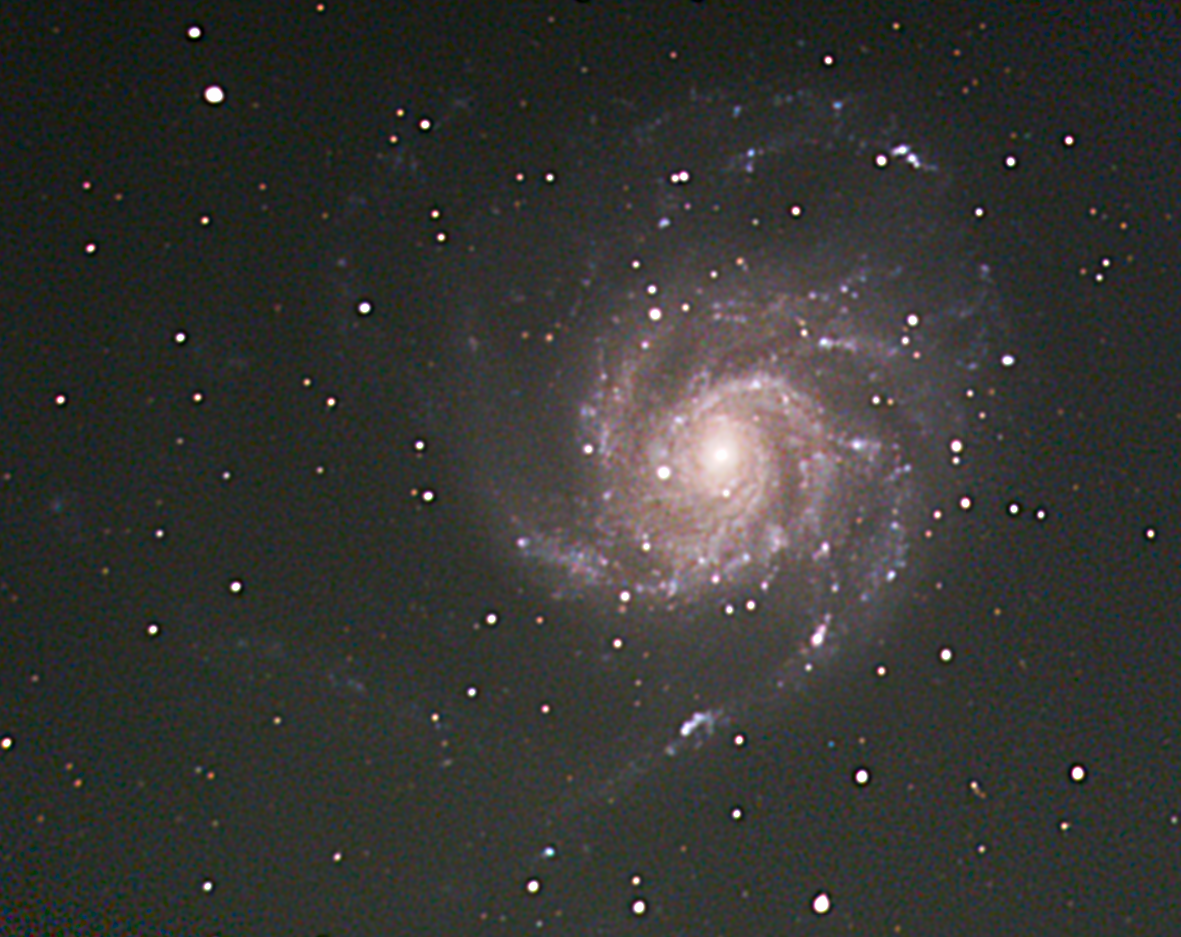
In the final images we can see some noise and even some "amp-glow". No dark frames were used in the processing. Well, I took some dark frames quite later on, with the camera at room temperature (hotter than original exposures). Anyway, after using dark frames in the processing with DSS, the SNR improves quite a lot. Then the contrast can be pushed a bit further and the final image looks cleaner and more beautiful:
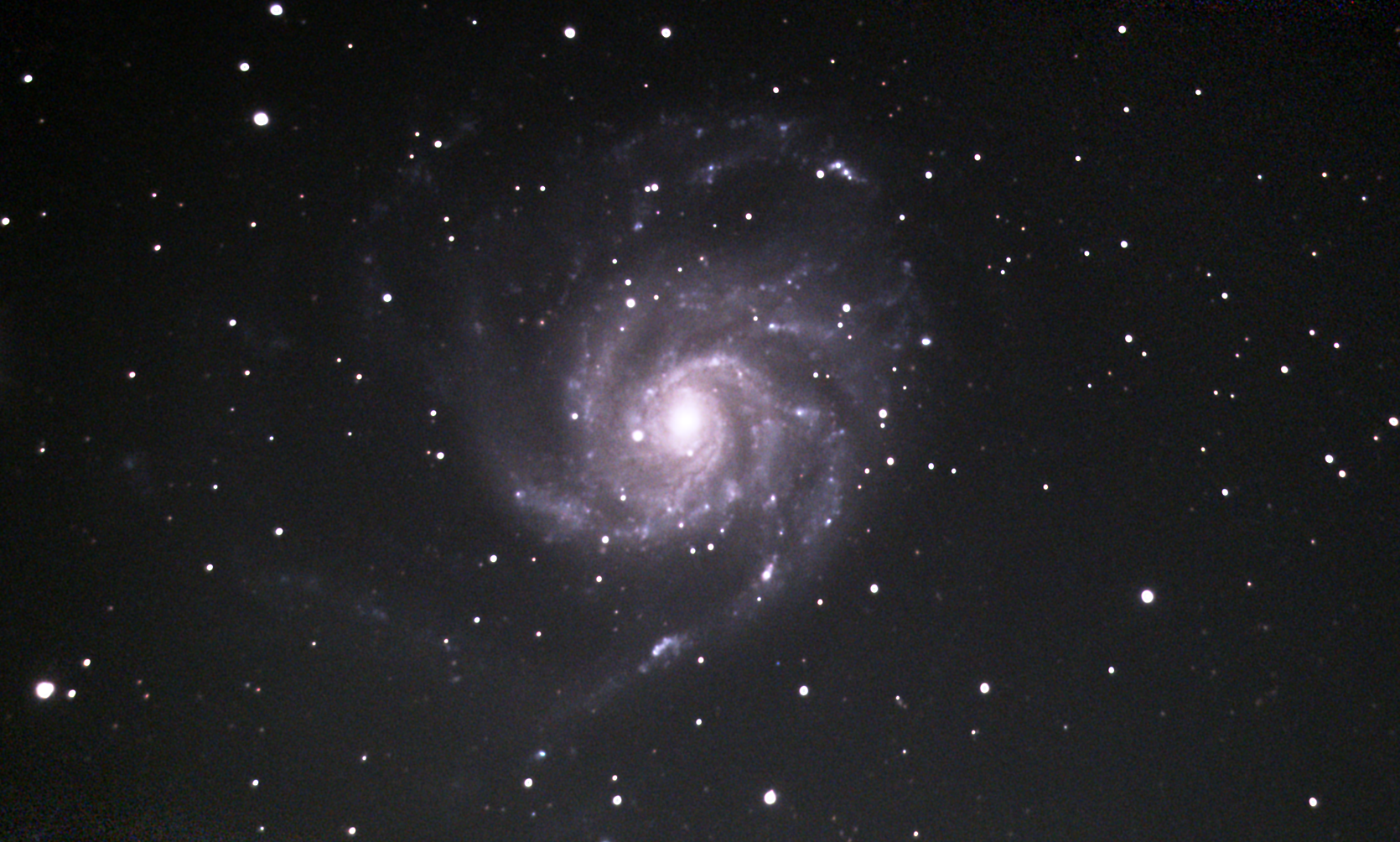
Third target: M51 + NGC 5195
My third Galaxy, M51, also known as the Whirlpool Galaxy. Actually there are two galaxies interacting, the smaller one known as NGC 5195. Located in Canes Venatici, about midnight it is near the zenith, which facilitates its observation, unless you are using and an Alt-Az mount and the telescope hits the mount... whops!
Magnitude 8.1
Located 31 million light-years from Earth, this spiral Galaxy has a diameter of 76,000 light-years, less than half the size of the Milky Way. To obtain this image I used no filter. The light hits the sensor directly after bouncing off the two mirrors of the telescope.
I used my new camera RisingTech G3M385C, which offers some more sensitivity and lower levels of noise compared with G3M290C. Pixels are 30% bigger. The images were taken the night of May 5 2021, with the gain at maximum, with exposures of 30 seconds. These images were therefore obtained at the limit of the capacity of the camera (maximum gain) and of the mount itself, which is not equatorial, thus limiting the exposure time to a maximum of 30 seconds.
Night without moon or clouds, but with quite poor visibility due to haze and humidity. Also, there were winds somewhere in the upper atmosphere, and stars were dancing in the dark...
Few useful images were obtained, about 40 images, manually selected from a set of 75 images. The images have been processed using Deep Space Stacker (DSS), GIMP and Fitswork.
The final result... well, the Whirlpool Galaxy can be seen!

Later on, on June 7th 2021, I took 500 new images, 15 seconds exposure with gain at maximum, with the camera RisingTech G3M385C. No moon, no clouds, almost no wind, finally! 10 Darks were taken and used during the exposures. The final result is much better:

Next year, in 2022, I took new images. The images were taken on the night of May 26, with maximum gain, with 15-second exposures. 10 Darks were taken and used during the exposures. In total, some 380 images were obtained (1.6 hours of exposure). I have selected 313 and processed them using Deep Space Stacker (DSS), GIMP and Registax (wavelets). The final result is the best I got so far for M51:

This time I used the IR/UV filter. And the color of the galaxy has changed quite significantly. Images taken without filter are reddish and the ones taken with the filter are bluish. This means that a great deal of near infrared is emitted by the galaxy. In the whole picture, a 15 magnitude, faint galaxy, can be seen in the lower right of the image.
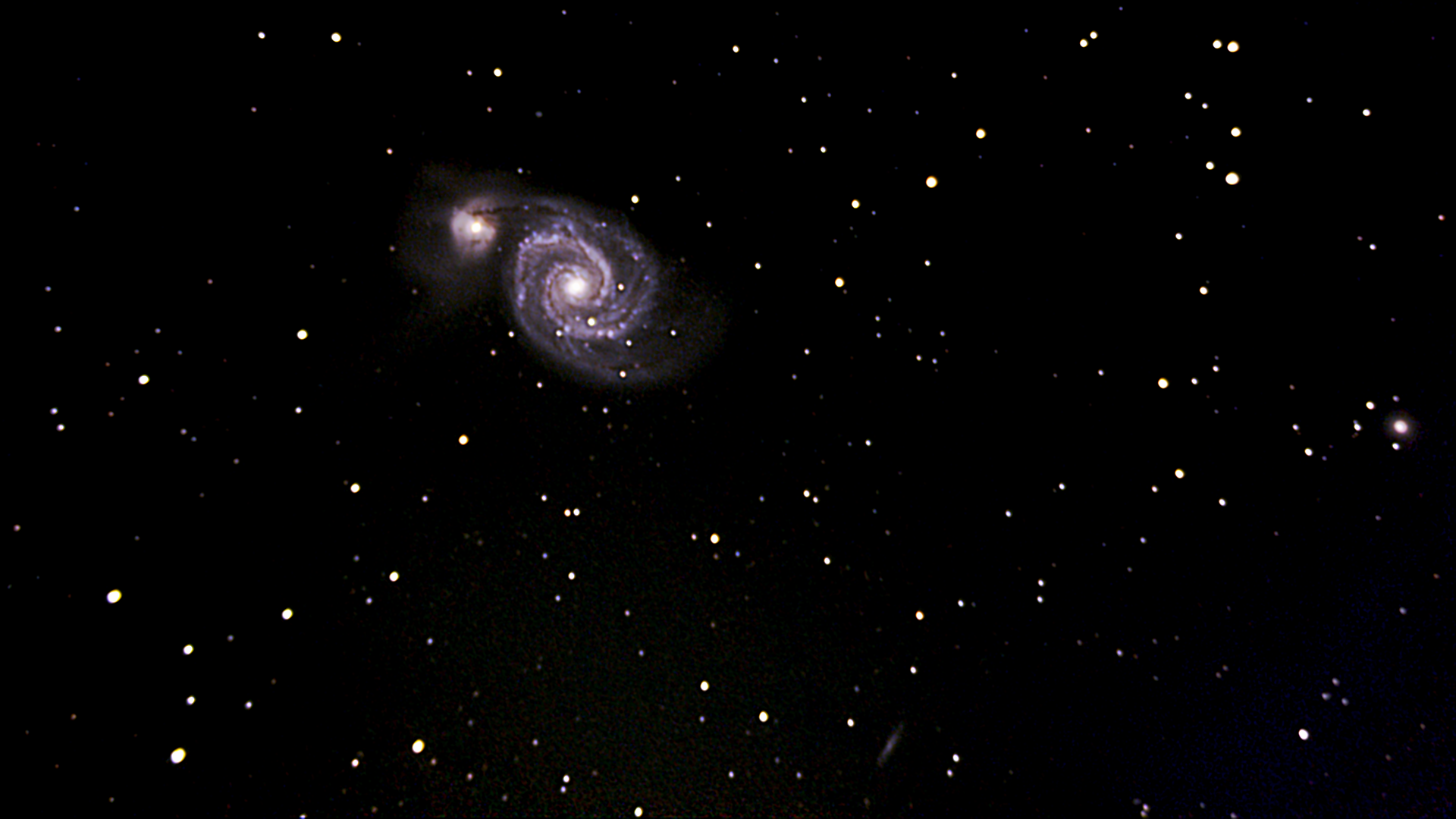
This galaxy is IC 4263. It seems incredible to me to be able to see galaxies of that magnitude, even if it only appears as a faint gray line. It is located at about 130M light years from earth. An enlargement follows:
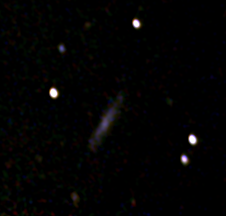
First globular cluster: M13
My first star cluster. M13 is a globular cluster in the constellation of Hercules. M13 is located 25.000 light-years from Earth with an apparent magnitude of 5.8. The cluster contain over 100.000 stars very densely packed together inside a diameter of about 145 light-years.
To get a good image with the maximum as possible number of stars, I took images with different exposures: 1s, 2s, 5s, 10s. A total number of 500 images were taken and stacked with DSS, then processed with GIMP and Registax. It was my first time with a globular cluster, and I feel quite satisfied about the result.
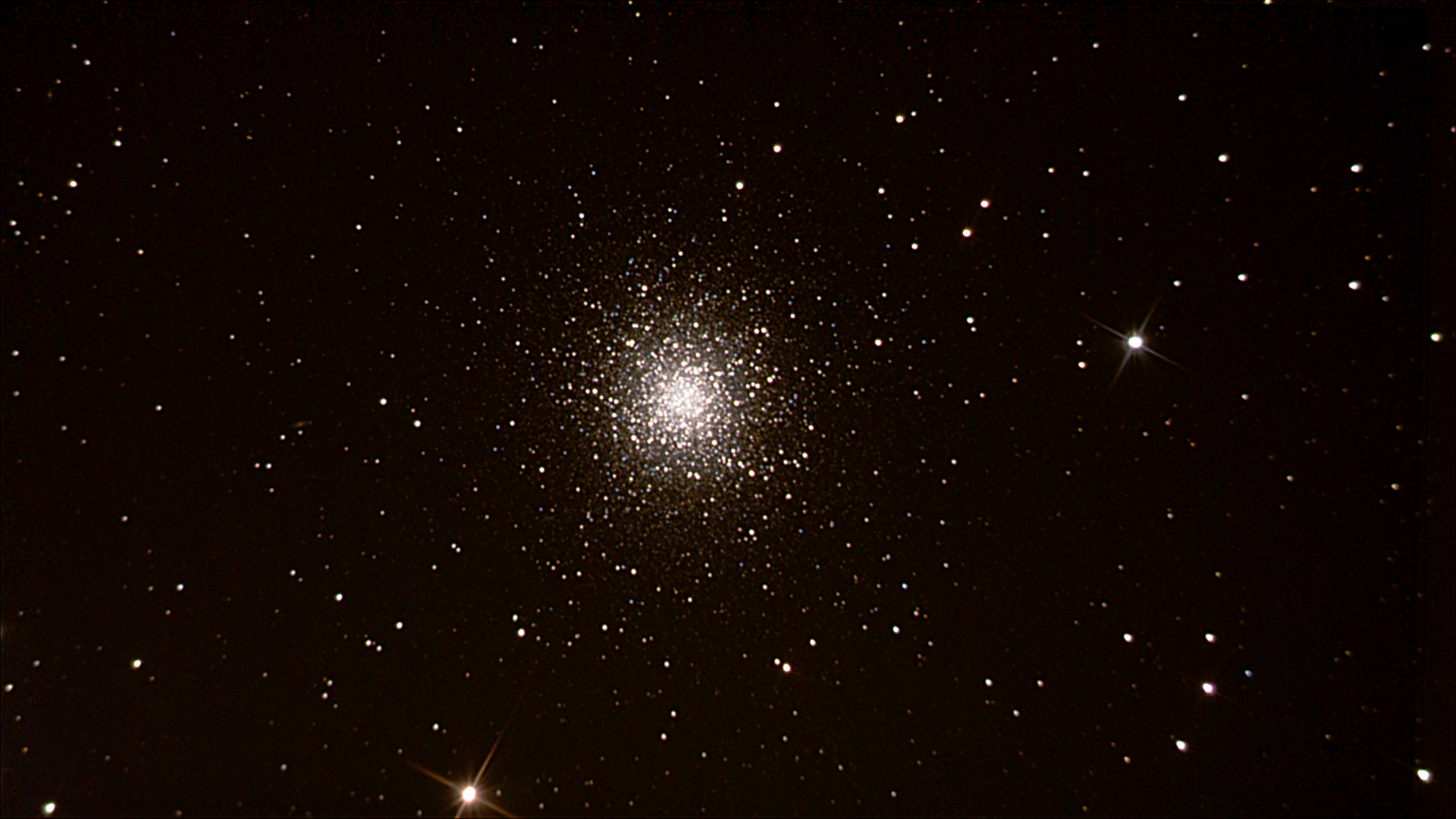
Fourth Galaxy : M106
Messier 106, a spiral galaxy in the Canes Venatici constellation. The size of M106 is approximately 135,000 light-years in diameter! It is 22 - 25 million light-years from Earth! You can also see two dwarf galaxies in the image; NGC 4248 in the lower right and UGC 7358 in the lower left.
Magnitude 8.4
To obtain this image I used no filter. The light hits the sensor directly after bouncing off the two mirrors of the telescope.
The images were taken the night of June 6 2021, with the camera G3M385C, with the gain at maximum, with exposures of 15 seconds.
Night without moon or clouds, but some haze and humidity.
About 200 images have been processed using Deep Space Stacker (DSS), GIMP and Fitswork.

Messier 63
Messier 63, also known as the Sunflower Galaxy, is a spiral galaxy in the northern constellation of Canes Venatici with approximately 400 billion stars. Diameter is 98000 light-years. Located at 29 milions light-years from Earth.
Magnitude 8.6.
To obtain this image I used IR-UV filter.
The images were taken the night of June 12 2021, with the camera G3M385C, with the gain at maximum, with exposures of 15 seconds.
Night without moon or clouds, but some haze and humidity.
About 500 images have been processed (2 hours total exposure) using Deep Space Stacker (DSS), GIMP and Registax (wavelets).
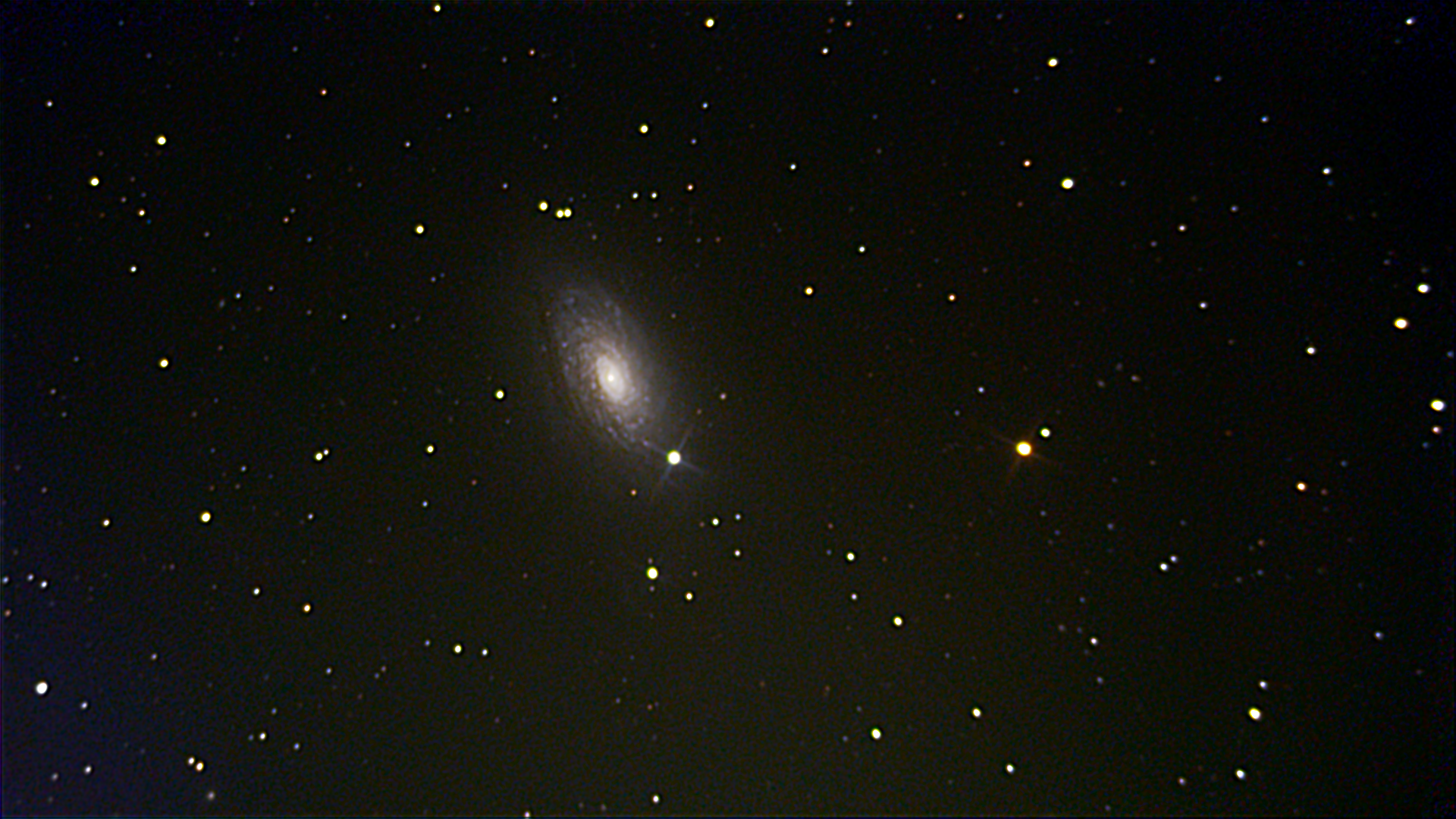
Messier 82
Messier 82, also known as the Cigar Galaxy, is an irregular galaxy located in the constellation Ursa Major. It is approximately 12 million light-years away and has a diameter of 37,000 light-years.
Magnitude 8.4.
To obtain this image I used IR-UV filter.
The images were taken the night of June 12 2021, with the camera G3M385C, with the gain at maximum, with exposures of 15 seconds.
Night without moon or clouds, but some haze and humidity.
About 200 images have been processed (about 1 hour total exposure) using Deep Space Stacker (DSS), GIMP and Registax (wavelets).
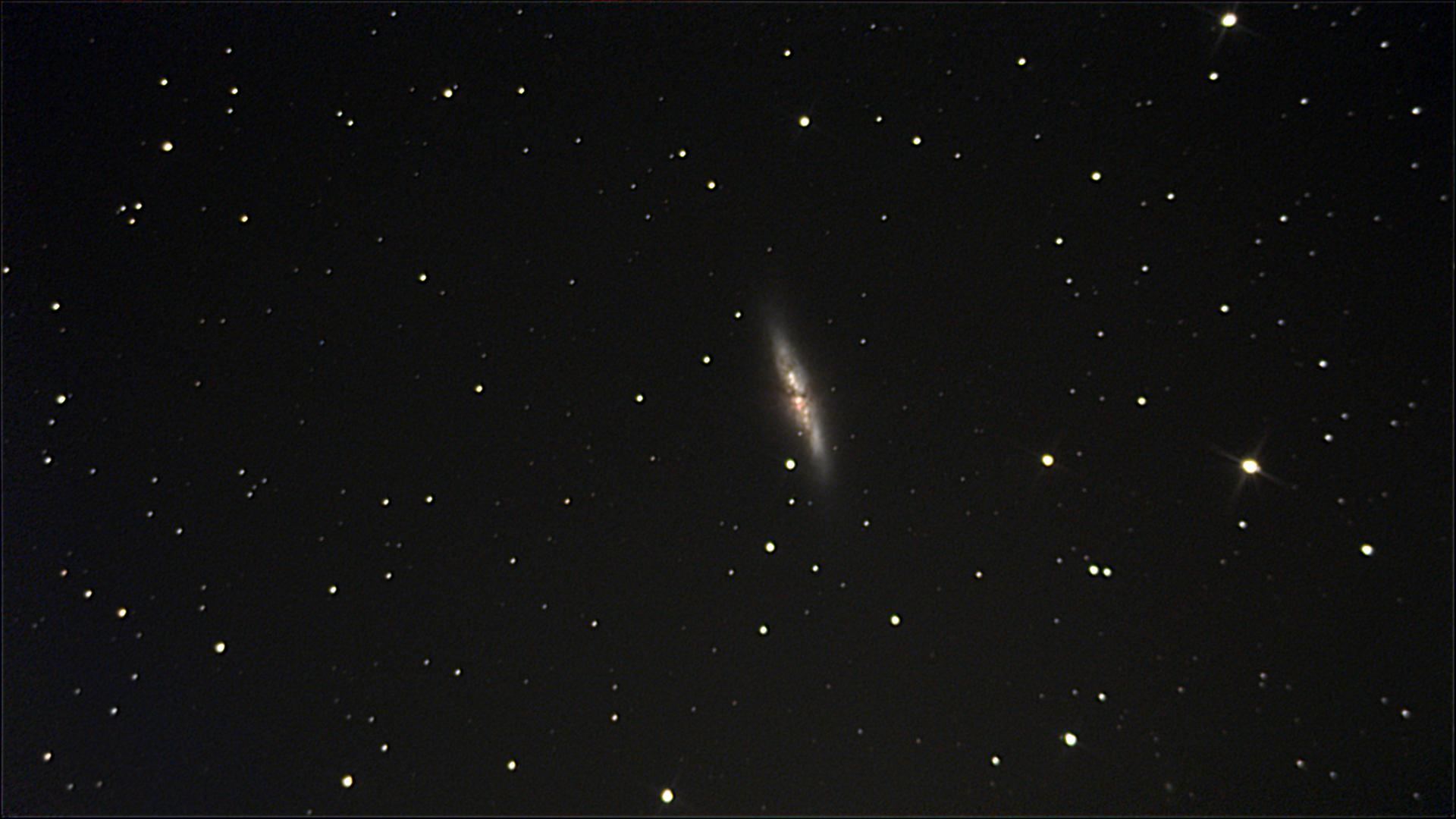
Messier 104
Galaxy M104, also known as the Sombrero Galaxy due to its particular appearance. It is a Galaxy that I have wanted for a long time, because it seems particularly beautiful to me. Where I live it always appears quite low on the horizon, in the constellation of Virgo, which makes it difficult to get quality images.
Magnitude 8.0
Located 31 million light-years from Earth, this spiral galaxy is 49,000 light-years in diameter, one-third the size of the Milky Way. I used the RisingTech G3M385 planetary camera, with UV/IR filter. The images were taken on the night of May 26 2022, with maximum gain, with 15-second exposures. Night without moon or clouds, but with limited visibility due to humidity. In total, some 368 images were obtained (1.6 hours of exposure) of which 239 have been useful. The images have been processed using Deep Space Stacker (DSS), GIMP and Registax (wavelets). The final result follows:

Messier 94
Messier 94 is a barred spiral galaxy in the constellation Canes Venatici. It is also known as the Cat's Eye Galaxy due to its bright core.
Magnitude 8.2
It is located about 16 million light years from Earth and has a diameter of about 45,000 light years. It has an extremely bright inner region surrounded by a bluish ring of young star clusters, around it is a dimmer region of older stars also surrounded by trails of young stars, and further out an outer ring much dimmer than just barely. It can be seen in the photo. I used the RisingTech G3M385 planetary camera, with UV/IR filter. The images were taken on the night of May 27 2022, with maximum gain, with 15-second exposures. Moonless night, few clouds, but with limited visibility due to humidity. In total, some 394 images were obtained (1.6 hours of exposure) of which 300 have been useful. The images have been processed using Deep Space Stacker (DSS), GIMP and Registax (wavelets).
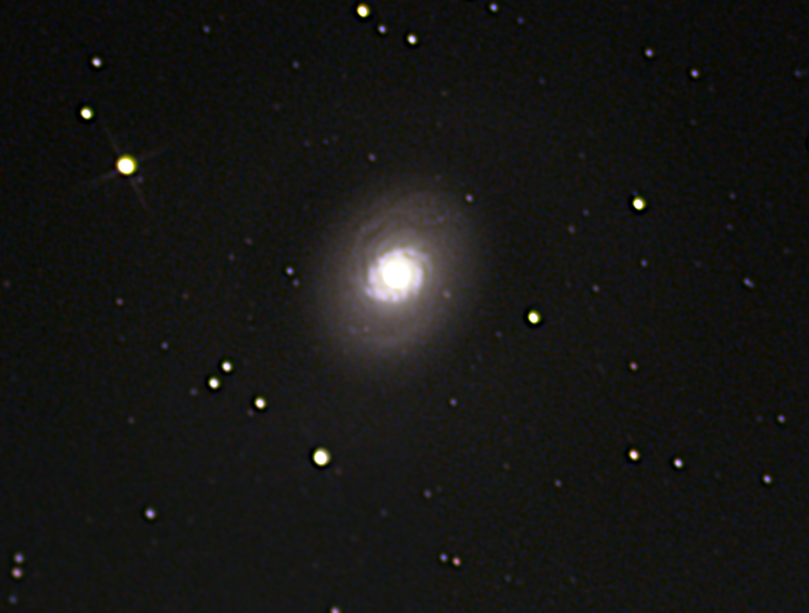
Messier 20
Night of June 22, 2022, finally the sky was clear, pleasant temperature and almost no wind.
The Trifid Nebula M20 is an excellent example of an emission (red part) and reflection (blue part) nebula. The red emission nebula contains a bright blue star cluster near its center. It emits red light because ultraviolet light from stars ionizes hydrogen gas, and hydrogen gas recombines, emitting the characteristic red hydrogen-alpha light. When the radiation from these hot young stars becomes too weak to ionize the hydrogen, the gas and dust reflect the original blue light.
The Trifid nebula, located in Sagittarius, has an extension of about 50 light years. It is located at a distance of approximately 4120 light years from Earth.
Magnitude 6.3
I used the RisingTech G3M385 planetary camera, with Sony IMX385 sensor and UV/IR filter.
Moonless night, few clouds, but with limited visibility due to humidity. This nebula is always quite low, about 25 degrees above the horizon at most, so light pollution complicates things. This time I took 300 images with 12 second exposures, of which I was only able to save 83. Even so, the final result allows us to see the Nebula in some detail.
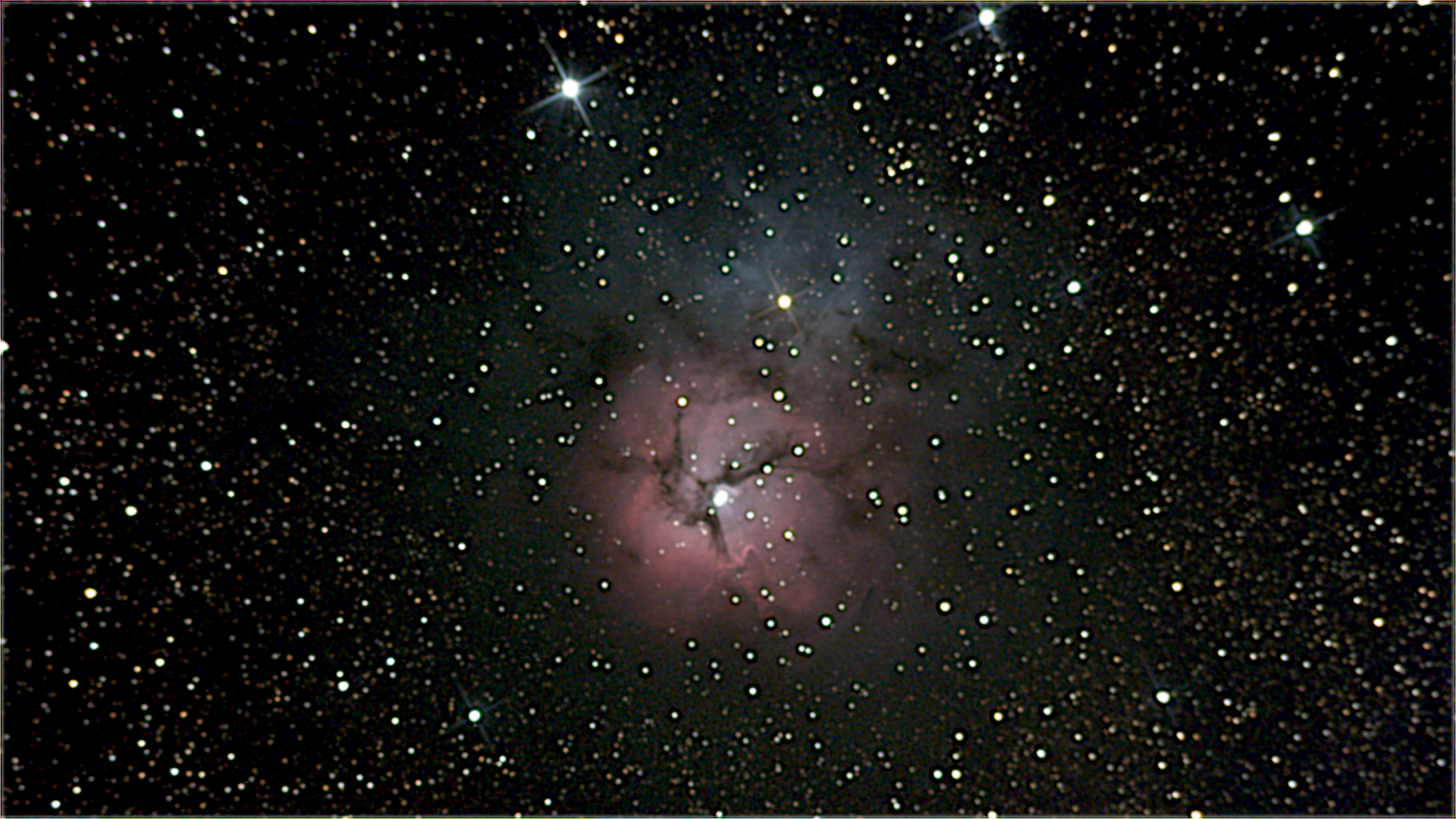
Messier 5
On the night of June 22 2022 I also took images of Messier 5, a globular cluster located in the constellation of the Serpent.
M5 is one of the oldest globular clusters in the Milky Way (about 14 billion years old) and contains about 500,000 stars. It is located at a distance of 24,500 light years from Earth, in the galactic halo of the Milky Way. M5 is one of the largest known globular clusters, with a diameter of about 165 light years.
Magnitude 6.7
I used the RisingTech G3M385 planetary camera with UV/IR filter. Moonless night, few clouds, but with limited visibility due to humidity. I took about 300 images with 2, 4, 8 and 16 second exposures, stacked using DSS and post processed using GIMP and Registax (wavelets).

Comet C/2017 K2 PanSTARRS
Last night, June 26 2022, I was taking images for the first time of a comet and observing its movement in the sky.
C/2017 K2 (PanSTARRS) is a comet from the Oort cloud and follows a hyperbolic orbit. It was discovered in May 2017 when it was beyond the orbit of Saturn. Right now it is about 280 million km from Earth and has a magnitude between 8-9. It is more or less close to Cebalrai (Beta Ophiuchi) on a background full of stars at the edge of the Milky Way.
This comet will reach perihelion on December 19. Time to time. Hopefully it will be very bright.
Two images are shown that correspond to the start and end of the session (1.5 hours interval). 25 images with 5-second exposures have been superimposed on the first image and 10 images with 10-second exposures on the second image. Unfortunately, with the light pollution and the humidity here, the tail is not visible.
I used the RisingTech G3M385 planetary camera, with Sony IMX385 sensor and UV/IR filter. Moonless night, few clouds.
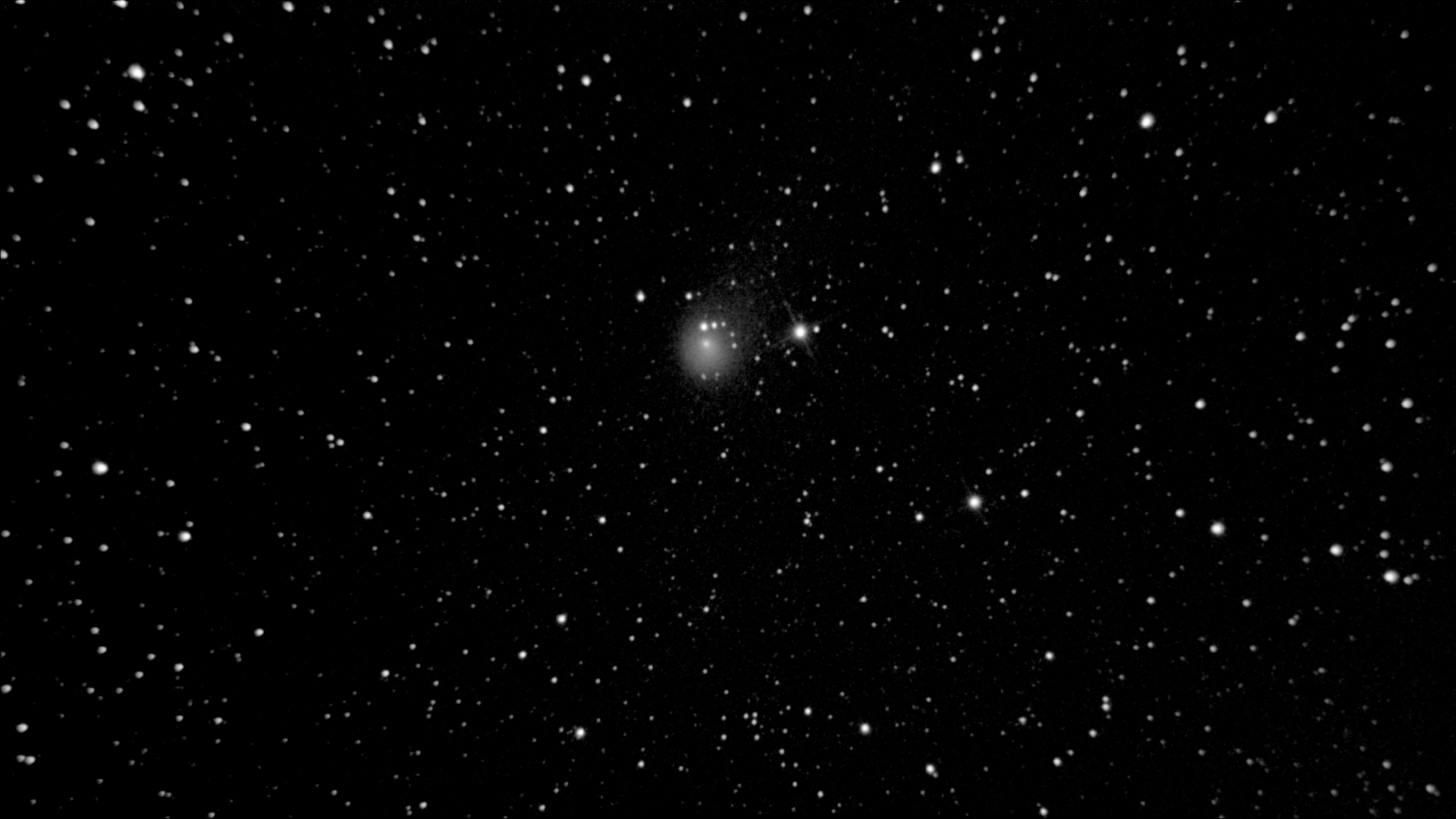

I know now how to use DSS to stack images from comets properly. So I stacked the 280 images of 10 seconds exposure that I got to try to get the tail of the comet. And the comet certainly has a tail:

Comet K2 has passed through the constellation of Ophiuchus and is lower on the horizon every day. Photo taken on August 1, from 300 images with exposures of 10 seconds with the telescope Skywatcher Skyhawk-1145p
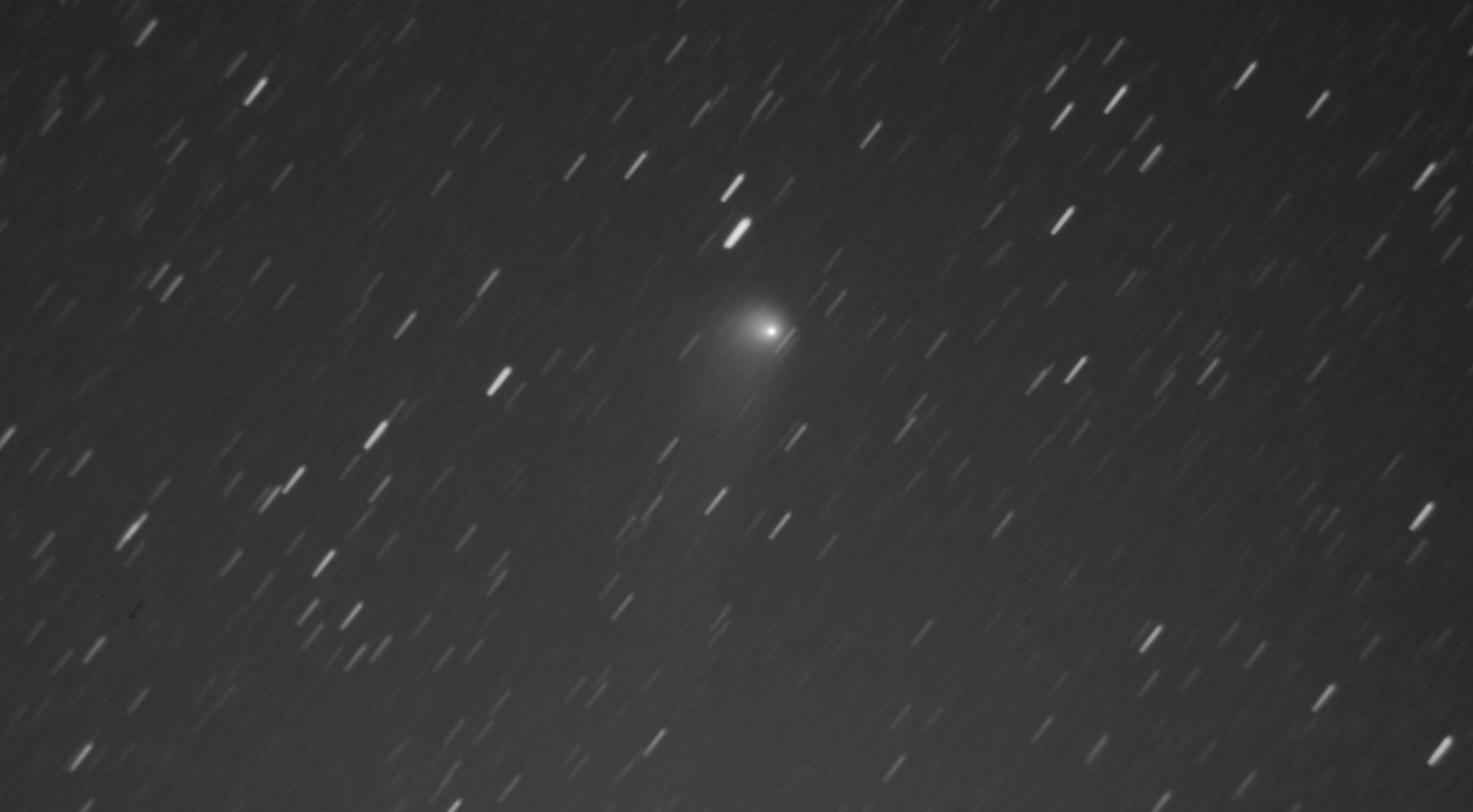
Messier 17
The night of June 26 was also for M17, the Omega nebula.
The Omega Nebula is an H II region in the constellation of Sagittarius and has magnitude 6. It is located at a distance of between 5,000 and 6,000 light years and is about 15 light years in diameter. It is considered one of the brightest and most massive star-forming regions in our galaxy.
I used the RisingTech G3M385 planetary camera, with Sony IMX385 sensor and UV/IR filter. Moonless night, few clouds.
10 second exposures. Took 300 images, of which 200 were useful. The final result of processing with GIMP and Registax is shown in the image.

Messier 57
It had been a long time since I took my friend Mak out for a walk, so taking advantage of the fact that I had the constellation Lyra at the zenith, I went for M57, the small but very famous Ring Nebula of Lyra.
M57 is a planetary nebula. It is located 2,300 light years from Earth and is observed at magnitude +8.80. The central star is a white dwarf slightly larger than the Sun. It is a very hot star, reaches 100,000K and has a magnitude of 15.8. This star is the one that originated the nebula. The degree of ionization of the matter in the ring decreases as the distance from the central star increases. The innermost region is rich in helium and is darker because it basically emits ultraviolet rays. In the visible part of the ring, the predominant color is green, corresponding to the forbidden transition of ionized oxygen and nitrogen. In the external part only the red radiation produced by hydrogen is observed.
On a clear, cloudless but humit night on July 10th, I used the Skywatcher Maksutov 127/1500 F12 telescope, Skywatcher Eq5 pro synscan goto mount, and the RisingTech G3M385 planetary camera, with Sony IMX385 sensor and UV/IR filter. About 60 useful 30-second exposures were taken. The images have been processed using DSS and Fitswork.
This is the first time I've used the Mak to photograph a deep space object, and I was surprised that despite working at F12, the image was bright enough to work with relatively short exposures.


Messier 16
M16, the Eagle Nebula. M16 is made up of a nebula and an open star cluster. It is located in the constellation Serpens (the Serpent). It is observed with magnitude 6.2 and is one of the brightest nebulae in the sky. This facilitates its observation even though in our latitudes it is quite low on the horizon.
The nebula emits a large amount of red light (HII region). The entire complex is about 7,000 light years away. The famous name given to the pillars of this nebula ("The Pillars of Creation") is because they are a breeding ground for stars.
There was a lot of humidity in the air, and although there was no Moon for most of the time, light pollution greatly affected the observation. Even near the zenith, a nebula of magnitude 7.2 was not well observed. Still, the nebula can be seen in all its splendor.
The PHD2 guidance system was used for the first time with the Skywatcher Eq5 Pro SynscanGoto mount. I used the Skywatcher Skyhawk-1145p telescope, Newton type, 450mm focal length, 114mm aperture, F4. RisingTech G3M385 planetary camera, with Sony IMX385 sensor and UV/IR filter. 200 images were obtained using 35-second exposures. The images were processed using DSS, Registax and Gimp. The end result is shown in the photo.

Messier 22
Messier 22 is a globular cluster located in the constellation of Sagittarius. It is one of the brightest globular clusters visible in the night sky, and has an apparent magnitude of 5.5, making it the brightest globular cluster at our latitudes. The brightest stars are magnitude 11.
Located about 10,400 light-years from our Solar System, M22 occupies a volume of about 200 light-years in diameter. It consists of at least 70,000 individual stars. Most of them are about the same age: about 12 billion years old and contain few metals.
The Skywatcher Eq5 Pro SynscanGoto mount was used with the Skywatcher Skyhawk-1145p telescope, Newton type, 450mm focal length, 114mm aperture, F4. RisingTech G3M385 planetary camera, with Sony IMX385 sensor and UV/IR filter. In August 1st, 200 images with 10-second exposures were obtained, which were processed using Deep Space Stacker (DSS) and GIMP. The end result is tremendous. According to DSS in the image there are 439 visible stars, although there are surely more.

